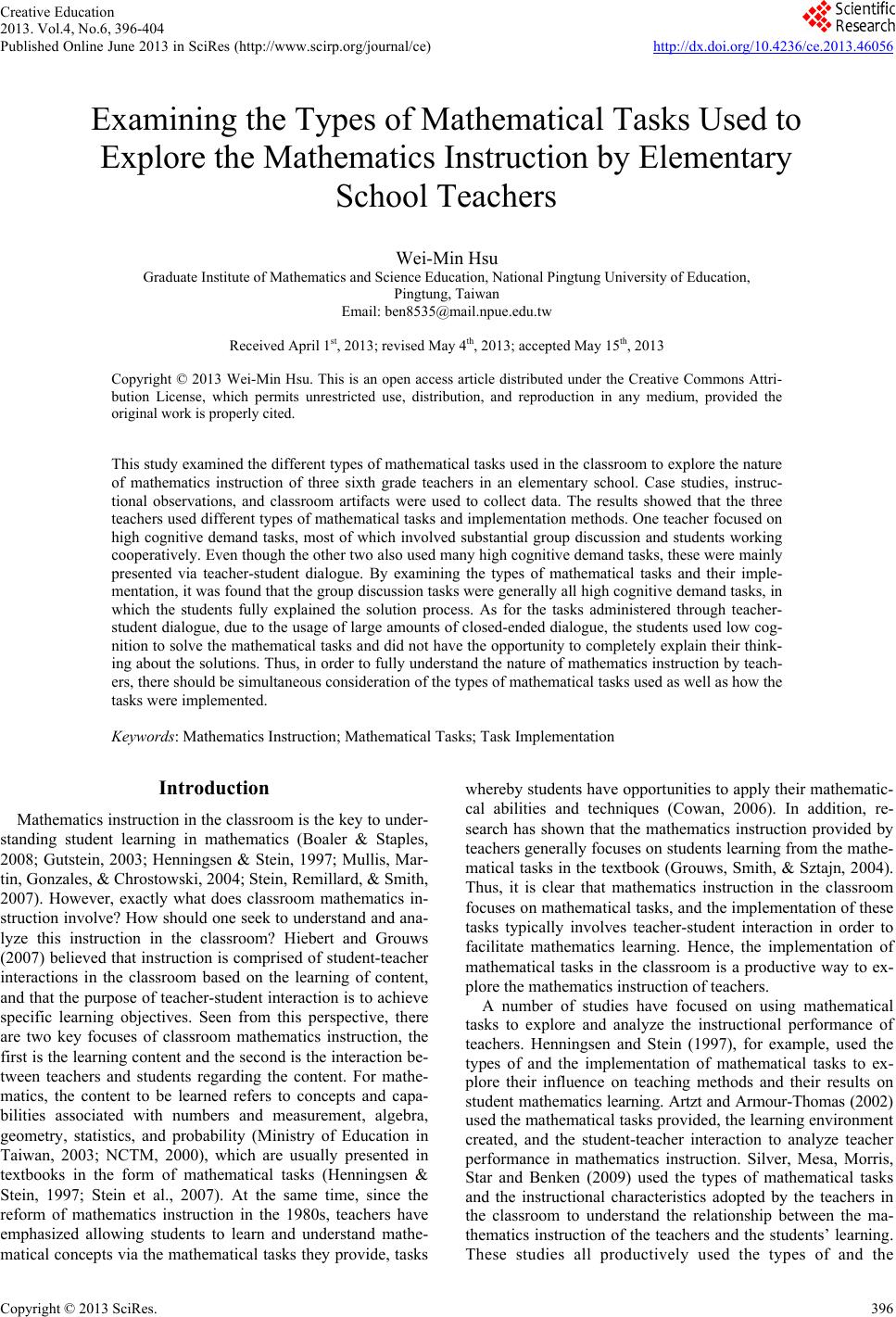 Creative Education 2013. Vol.4, No.6, 396-404 Published Online June 2013 in SciRes (http://www.scirp.org/journal/ce) http://dx.doi.org/10.4236/ce.2013.46056 Copyright © 2013 SciR e s . 396 Examining the Types of Mathematical Tasks Used to Explore the Mathematics Instruction by Elementary School Teachers Wei-Min Hsu Graduate Institute of Mathematics and Science Education, National Pingtung University of Education, Pingtung, Taiwan Email: ben8535@mail.npue.edu.tw Received April 1st, 2013; revised May 4th, 2013; accepted May 15th, 2013 Copyright © 2013 Wei-Min Hsu. This is an open access article distributed under the Creative Commons Attri- bution License, which permits unrestricted use, distribution, and reproduction in any medium, provided the original work is properly cited. This study examined the different types of mathematical tasks used in the classroom to explore the nature of mathematics instruction of three sixth grade teachers in an elementary school. Case studies, instruc- tional observations, and classroom artifacts were used to collect data. The results showed that the three teachers used different types of mathematical tasks and implementation methods. One teacher focused on high cognitive demand tasks, most of which involved substantial group discussion and students working cooperatively. Even though the other two also used many high cognitive demand tasks, these were mainly presented via teacher-student dialogue. By examining the types of mathematical tasks and their imple- mentation, it was found that the group discussion tasks were generally all high cognitive demand tasks, in which the students fully explained the solution process. As for the tasks administered through teacher- student dialogue, due to the usage of large amounts of closed-ended dialogue, the students used low cog- nition to solve the mathematical tasks and did not have the opportunity to completely explain their think- ing about the solutions. Thus, in order to fully understand the nature of mathematics instruction by teach- ers, there should be simultaneous consideration of the types of mathematical tasks used as well as how the tasks were implemented. Keywords: Mathematics Instruction; Mathematical Tasks; Task Implementation Introduction Mathematics instruction in the classroom is the key to under- standing student learning in mathematics (Boaler & Staples, 2008; Gutstein, 2003; Henningsen & Stein, 1997; Mullis, Mar- tin, Gonzales, & Chrostowski, 2004; Stein, Remillard, & Smith, 2007). However, exactly what does classroom mathematics in- struction involve? How should one seek to understand and ana- lyze this instruction in the classroom? Hiebert and Grouws (2007) believed that instruction is comprised of student-teacher interactions in the classroom based on the learning of content, and that the purpose of teacher-student interaction is to achieve specific learning objectives. Seen from this perspective, there are two key focuses of classroom mathematics instruction, the first is the learning content and the second is the interaction be- tween teachers and students regarding the content. For mathe- matics, the content to be learned refers to concepts and capa- bilities associated with numbers and measurement, algebra, geometry, statistics, and probability (Ministry of Education in Taiwan, 2003; NCTM, 2000), which are usually presented in textbooks in the form of mathematical tasks (Henningsen & Stein, 1997; Stein et al., 2007). At the same time, since the reform of mathematics instruction in the 1980s, teachers have emphasized allowing students to learn and understand mathe- matical concepts via the mathematical tasks they provide, tasks whereby students have opportunities to apply their mathematic- cal abilities and techniques (Cowan, 2006). In addition, re- search has shown that the mathematics instruction provided by teachers generally focuses on students learning from the mathe- matical tasks in the textbook (Grouws, Smith, & Sztajn, 2004). Thus, it is clear that mathematics instruction in the classroom focuses on mathematical tasks, and the implementation of these tasks typically involves teacher-student interaction in order to facilitate mathematics learning. Hence, the implementation of mathematical tasks in the classroom is a productive way to ex- plore the mathematics instruction of teachers. A number of studies have focused on using mathematical tasks to explore and analyze the instructional performance of teachers. Henningsen and Stein (1997), for example, used the types of and the implementation of mathematical tasks to ex- plore their influence on teaching methods and their results on stu den t m ath ematics learning. Artzt and Armour- Thomas (2002) used the mathematical tasks provided, the learning environment created, and the student-teacher interaction to analyze teacher performance in mathematics instruction. Silver, Mesa, Morris, Star and Benken (2009) used the types of mathematical tasks and the instructional characteristics adopted by the teachers in the classroom to understand the relationship between the ma- thematics instruction of the teachers and the students’ learning. These studies all productively used the types of and the 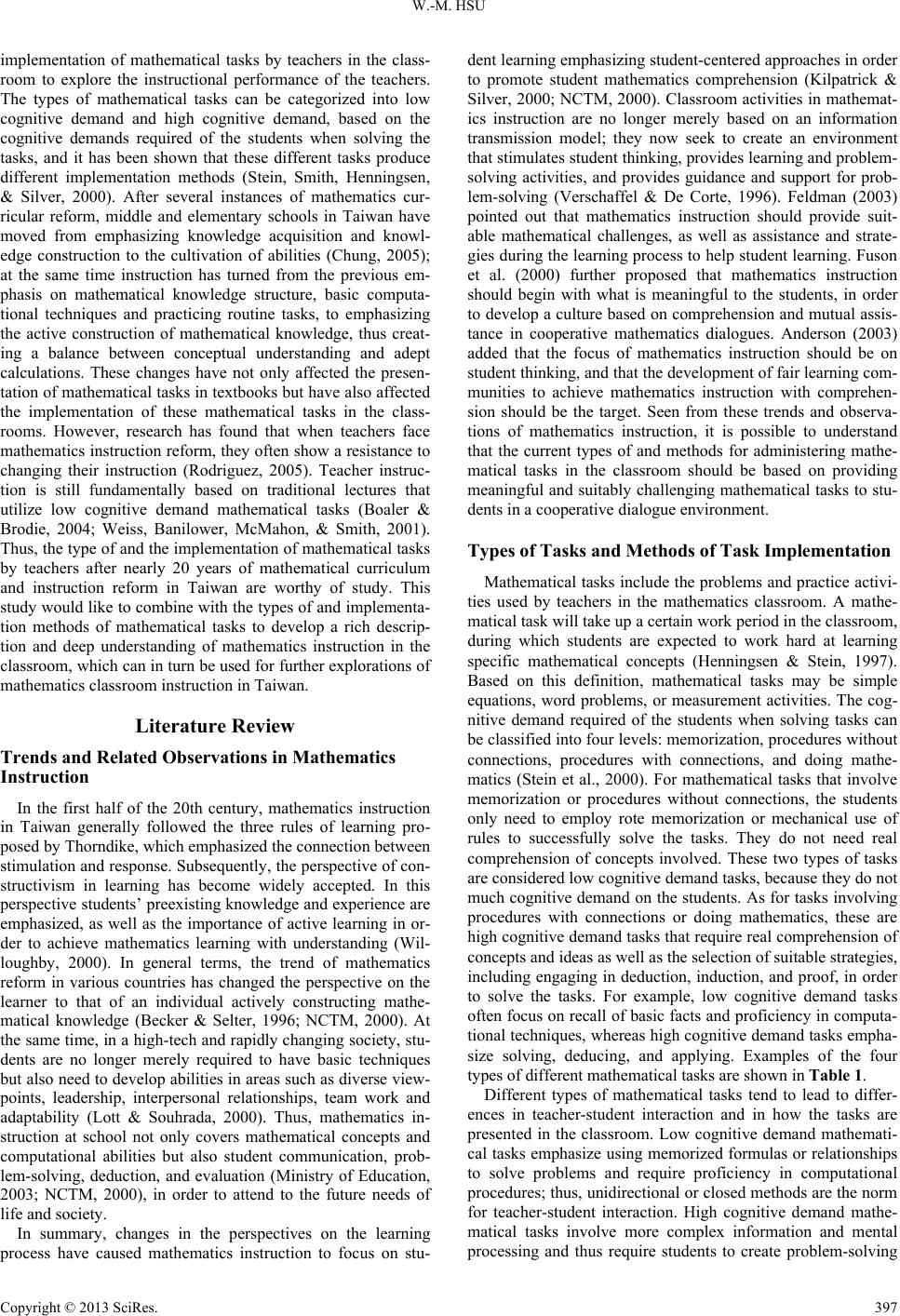 W.-M. HSU implementation of mathematical tasks by teachers in the class- room to explore the instructional performance of the teachers. The types of mathematical tasks can be categorized into low cognitive demand and high cognitive demand, based on the cognitive demands required of the students when solving the tasks, and it has been shown that these different tasks produce different implementation methods (Stein, Smith, Henningsen, & Silver, 2000). After several instances of mathematics cur- ricular reform, middle and elementary schools in Taiwan have moved from emphasizing knowledge acquisition and knowl- edge construction to the cultivation of abilities (Chung, 2005); at the same time instruction has turned from the previous em- phasis on mathematical knowledge structure, basic computa- tional techniques and practicing routine tasks, to emphasizing the active construction of mathematical knowledge, thus creat- ing a balance between conceptual understanding and adept calculations. These changes have not only affected the presen- tation of mathematical tasks in textbooks but have also affected the implementation of these mathematical tasks in the class- rooms. However, research has found that when teachers face mathematics instruction reform, they often show a resistance to changing their instruction (Rodriguez, 2005). Teacher instruc- tion is still fundamentally based on traditional lectures that utilize low cognitive demand mathematical tasks (Boaler & Brodie, 2004; Weiss, Banilower, McMahon, & Smith, 2001). Thus, the type of and the implementation of mathematical tasks by teachers after nearly 20 years of mathematical curriculum and instruction reform in Taiwan are worthy of study. This study would like to combine with the types of and implementa- tion methods of mathematical tasks to develop a rich descrip- tion and deep understanding of mathematics instruction in the classroom, which can in turn be used for further explorations of mathematics classroom instruction in Taiwan. Literature Review Trends and Related Observations in Mathematics Instruction In the first half of the 20th century, mathematics instruction in Taiwan generally followed the three rules of learning pro- posed by Thorndike, which emphasized the connection between stimulation and response. Subsequently, the perspective of con- structivism in learning has become widely accepted. In this perspective students’ preexisting knowledge and experience are emphasized, as well as the importance of active learning in or- der to achieve mathematics learning with understanding (Wil- loughby, 2000). In general terms, the trend of mathematics reform in various countries has changed the perspective on the learner to that of an individual actively constructing mathe- matical knowledge (Becker & Selter, 1996; NCTM, 2000). At the same time, in a high-tech and rapidly changing society, stu- dents are no longer merely required to have basic techniques but also need to develop abilities in areas such as diverse view- points, leadership, interpersonal relationships, team work and adaptability (Lott & Souhrada, 2000). Thus, mathematics in- struction at school not only covers mathematical concepts and computational abilities but also student communication, prob- lem-solving, deduction, and evaluation (Ministry of Education, 2003; NCTM, 2000), in order to attend to the future needs of life and society. In summary, changes in the perspectives on the learning process have caused mathematics instruction to focus on stu- dent learning emphasizing student-centered approaches in order to promote student mathematics comprehension (Kilpatrick & Silver, 2000; NCTM, 2000). Classroom activities in mathemat- ics instruction are no longer merely based on an information transmission model; they now seek to create an environment that stimulates student thinking, provides learning and problem- solving activities, and provides guidance and support for prob- lem-solving (Verschaffel & De Corte, 1996). Feldman (2003) pointed out that mathematics instruction should provide suit- able mathematical challenges, as well as assistance and strate- gies during the learning process to help student learning. Fuson et al. (2000) further proposed that mathematics instruction should begin with what is meaningful to the students, in order to deve lop a culture b ased on comprehension and mutual assis- tance in cooperative mathematics dialogues. Anderson (2003) added that the focus of mathematics instruction should be on student thinking, and that the development of fair learning com- munities to achieve mathematics instruction with comprehen- sion should be the target. Seen from these trends and observa- tions of mathematics instruction, it is possible to understand that the current types of and methods for administering mathe- matical tasks in the classroom should be based on providing meaningful and suitably challenging mathematical tasks to stu- dents in a cooperative dialogue environment. Types of Tasks and Methods of Task Implementation Mathematical tasks include the problems and practice activi- ties used by teachers in the mathematics classroom. A mathe- matical task will take up a certain work period in the classroom, during which students are expected to work hard at learning specific mathematical concepts (Henningsen & Stein, 1997). Based on this definition, mathematical tasks may be simple equations, word problems, or measurement activities. The cog- nitive demand required of the students when solving tasks can be classified into four levels: memorization, procedures without connections, procedures with connections, and doing mathe- matics (Stein et al., 2000). For mathematical tasks that involve memorization or procedures without connections, the students only need to employ rote memorization or mechanical use of rules to successfully solve the tasks. They do not need real comprehension of concepts involved. These two types of tasks are considered low cognitive demand tasks, because they do not much cognitive demand on the students. As for tasks involving procedures with connections or doing mathematics, these are high cognitive demand tasks that require real comprehension of concepts and ideas as well as the selection of suitable strategies, including engaging in deduction, induction, and proof, in order to solve the tasks. For example, low cognitive demand tasks often focus on recall of basic facts and proficiency in computa- tional techniques, whereas high cognitive demand tasks empha- size solving, deducing, and applying. Examples of the four types of different mathematical tasks are shown in Table 1. Different types of mathematical tasks tend to lead to differ- ences in teacher-student interaction and in how the tasks are presented in the classroom. Low cognitive demand mathemati- cal tasks emphasize using memorized formulas or relationships to solve problems and require proficiency in computational procedures; thus, unidirectional or closed methods are the norm for teacher-student interaction. High cognitive demand mathe- matical tasks involve more complex information and mental processing and thus require students to create problem-solving Copyright © 2013 SciRe s . 397 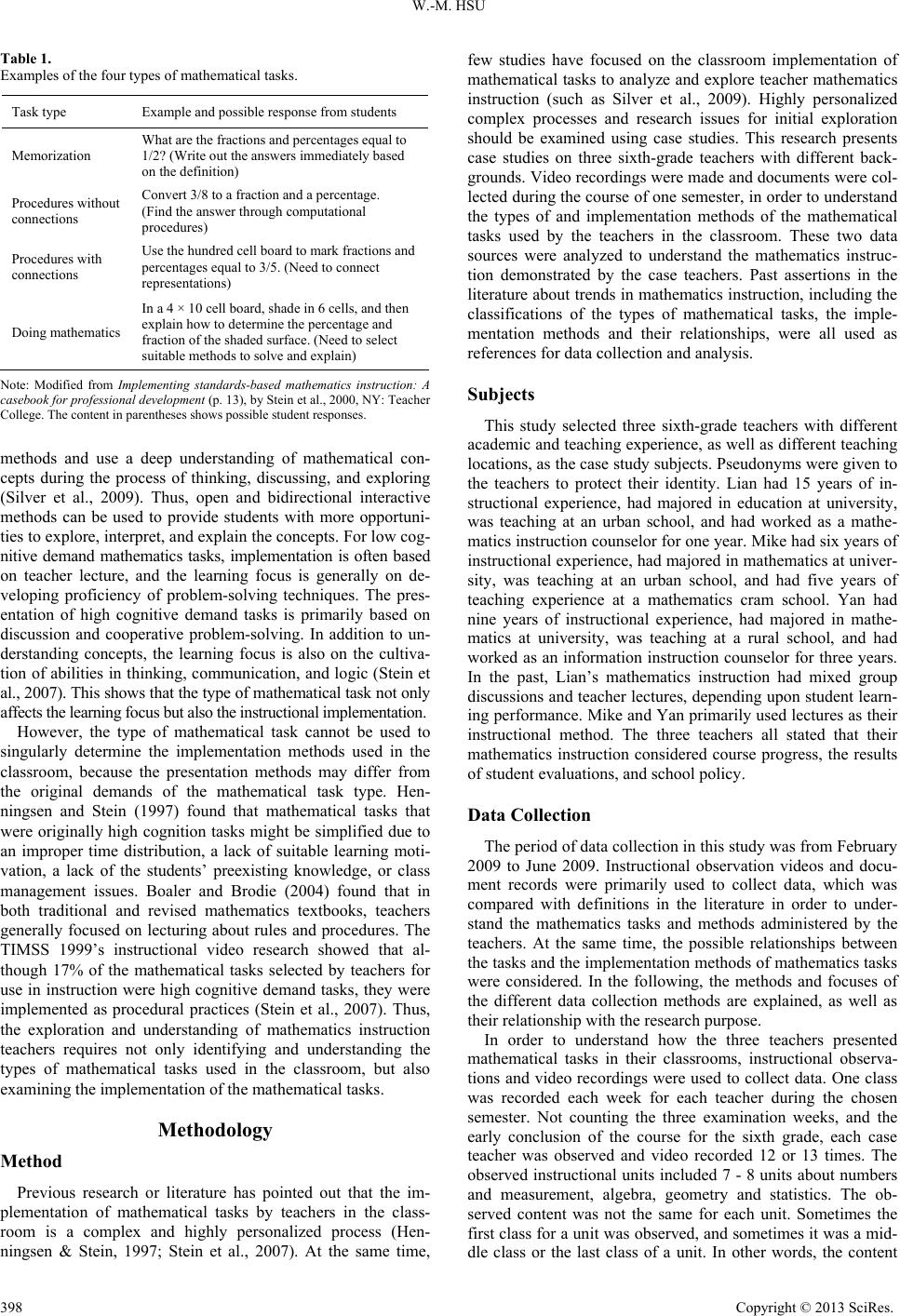 W.-M. HSU Table 1. Examples of the four types of mathematical tasks. Task type Example and possible response from students Memorization What are the fractions and perc entages equal to 1/2? (Write out the answers im mediately based on the definition) Procedures without connections Convert 3/8 to a fraction and a perce n tage. (Find the answer through computational procedures) Procedures with connections Use the hundred cell board to mark f ractions and percentag es equal to 3 / 5. (Need to connect representations) Doing math e m atics In a 4 × 10 cell board, shade in 6 cells, a n d then explain how to determine the pe rcentage and fraction of the shaded surface. (Need to select suitable m ethods to solve and explain) Note: Modified from Implementing standards-based mathematics instruction: A casebook for pro fess ional develo pmen t (p. 13), by Stein et al., 2000, NY: Teacher College. The content in parentheses shows possible s tudent responses. methods and use a deep understanding of mathematical con- cepts during the process of thinking, discussing, and exploring (Silver et al., 2009). Thus, open and bidirectional interactive methods can be used to provide students with more opportuni- ties to explore, interpret, and explain the concepts. For low cog- nitive demand mathematics tasks, implementation is often based on teacher lecture, and the learning focus is generally on de- veloping proficiency of problem-solving techniques. The pres- entation of high cognitive demand tasks is primarily based on discussion and cooperative problem-solving. In addition to un- derstanding concepts, the learning focus is also on the cultiva- tion of abilities in thinking, communication, and logic (Stein et al., 2007). This shows that the ty pe of mathematical task not only affects the learning focus but also the instructional implementation. However, the type of mathematical task cannot be used to singularly determine the implementation methods used in the classroom, because the presentation methods may differ from the original demands of the mathematical task type. Hen- ningsen and Stein (1997) found that mathematical tasks that were originally high cognition tasks might be simplified due to an improper time distribution, a lack of suitable learning moti- vation, a lack of the students’ preexisting knowledge, or class management issues. Boaler and Brodie (2004) found that in both traditional and revised mathematics textbooks, teachers generally focused on lecturing about rules and procedures. The TIMSS 1999’s instructional video research showed that al- though 17% of the mathematical tasks selected by teachers for use in instruction were high cognitive demand tasks, they were implemented as procedural practices (Stein et al., 2007). Thus, the exploration and understanding of mathematics instruction teachers requires not only identifying and understanding the types of mathematical tasks used in the classroom, but also examining the implementation of the mathematical tasks. Methodology Method Previous research or literature has pointed out that the im- plementation of mathematical tasks by teachers in the class- room is a complex and highly personalized process (Hen- ningsen & Stein, 1997; Stein et al., 2007). At the same time, few studies have focused on the classroom implementation of mathematical tasks to analyze and explore teacher mathematics instruction (such as Silver et al., 2009). Highly personalized complex processes and research issues for initial exploration should be examined using case studies. This research presents case studies on three sixth-grade teachers with different back- grounds. Video recordings were made and documents were col- lected during the course of one semester, in order to understand the types of and implementation methods of the mathematical tasks used by the teachers in the classroom. These two data sources were analyzed to understand the mathematics instruc- tion demonstrated by the case teachers. Past assertions in the literature about trends in mathematics instruction, including the classifications of the types of mathematical tasks, the imple- mentation methods and their relationships, were all used as references for data collection and analysis. Subjects This study selected three sixth-grade teachers with different academic and teaching experience, as well as different teaching locations, as the case study subjects. Pseudonyms were given to the teachers to protect their identity. Lian had 15 years of in- structional experience, had majored in education at university, was teaching at an urban school, and had worked as a mathe- matics instruction counselor for one year. Mike had six years of instructional experience, had majored in mathematics at univer- sity, was teaching at an urban school, and had five years of teaching experience at a mathematics cram school. Yan had nine years of instructional experience, had majored in mathe- matics at university, was teaching at a rural school, and had worked as an information instruction counselor for three years. In the past, Lian’s mathematics instruction had mixed group discussions and teacher lectures, depending upon student learn- ing performance. Mike and Yan primarily used lectures as their instructional method. The three teachers all stated that their mathematics instruction considered course progress, the results of student evaluations, and school policy. Data Collection The period of data collection in this study was from February 2009 to June 2009. Instructional observation videos and docu- ment records were primarily used to collect data, which was compared with definitions in the literature in order to under- stand the mathematics tasks and methods administered by the teachers. At the same time, the possible relationships between the tasks and the implementation methods of mathematics tasks were considered. In the following, the methods and focuses of the different data collection methods are explained, as well as their relationship with the research purpose. In order to understand how the three teachers presented mathematical tasks in their classrooms, instructional observa- tions and video recordings were used to collect data. One class was recorded each week for each teacher during the chosen semester. Not counting the three examination weeks, and the early conclusion of the course for the sixth grade, each case teacher was observed and video recorded 12 or 13 times. The observed instructional units included 7 - 8 units about numbers and measurement, algebra, geometry and statistics. The ob- served content was not the same for each unit. Sometimes the first class for a unit was observed, and sometimes it was a mid- dle class or the last class of a unit. In other words, the content Copyright © 2013 SciRe s . 398 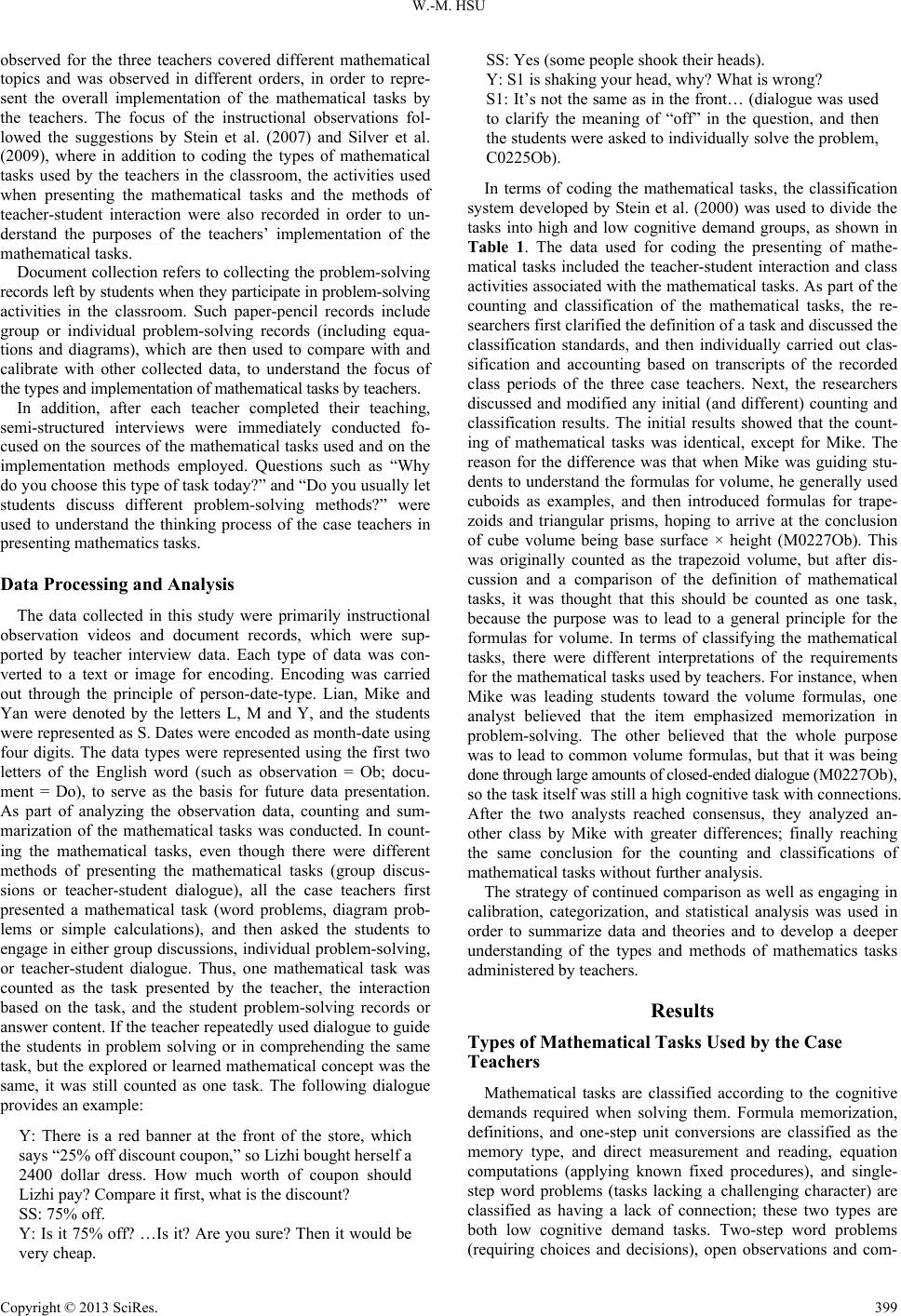 W.-M. HSU observed for the three teachers covered different mathematical topics and was observed in different orders, in order to repre- sent the overall implementation of the mathematical tasks by the teachers. The focus of the instructional observations fol- lowed the suggestions by Stein et al. (2007) and Silver et al. (2009), where in addition to coding the types of mathematical tasks used by the teachers in the classroom, the activities used when presenting the mathematical tasks and the methods of teacher-student interaction were also recorded in order to un- derstand the purposes of the teachers’ implementation of the mathematical tasks. Document collection refers to collecting the problem-solving records left by student s when they participate in proble m-solving activities in the classroom. Such paper-pencil records include group or individual problem-solving records (including equa- tions and diagrams), which are then used to compare with and calibrate with other collected data, to understand the focus of the types and implementation of mathematical tasks by teachers. In addition, after each teacher completed their teaching, semi-structured interviews were immediately conducted fo- cused on the sources of the mathematical tasks used and on the implementation methods employed. Questions such as “Why do you choose this type of task today?” and “Do y ou usually let students discuss different problem-solving methods?” were used to understand the thinking process of the case teachers in presenting mathematics tasks. Data Processing and An a l ysis The data collected in this study were primarily instructional observation videos and document records, which were sup- ported by teacher interview data. Each type of data was con- verted to a text or image for encoding. Encoding was carried out through the principle of person-date-type. Lian, Mike and Yan were denoted by the letters L, M and Y, and the students were represented as S. Dates were encoded as month-date using four digits. The data types were represented using the first two letters of the English word (such as observation = Ob; docu- ment = Do), to serve as the basis for future data presentation. As part of analyzing the observation data, counting and sum- marization of the mathematical tasks was conducted. In count- ing the mathematical tasks, even though there were different methods of presenting the mathematical tasks (group discus- sions or teacher-student dialogue), all the case teachers first presented a mathematical task (word problems, diagram prob- lems or simple calculations), and then asked the students to engage in either group discussions, individual problem-solving, or teacher-student dialogue. Thus, one mathematical task was counted as the task presented by the teacher, the interaction based on the task, and the student problem-solving records or answer content. If the teacher repeatedly used dialogue to guide the students in problem solving or in comprehending the same task, but the explored or learned mathematical concept was the same, it was still counted as one task. The following dialogue provides an example: Y: There is a red banner at the front of the store, which says “25% off discount coupon,” so Lizhi bought herself a 2400 dollar dress. How much worth of coupon should Lizhi pay? Compare it first, what is the discount? SS: 75% off. Y: Is it 75% off? …Is it? Are you sure? Then it would be very cheap. SS: Yes (some people shook their heads). Y: S1 is shaking your head, why? What is wrong? S1: It’s not the same as in the front… (dialogue was used to clarify the meaning of “off” in the question, and then the students were asked to individually solve the problem, C0225Ob). In terms of coding the mathematical tasks, the classification system developed by Stein et al. (2000) was used to divide the tasks into high and low cognitive demand groups, as shown in Table 1. The data used for coding the presenting of mathe- matical tasks included the teacher-student interaction and class activities associated with the mathematical tasks. As part of the counting and classification of the mathematical tasks, the re- searchers first clarified the definition of a task and discussed the classification standards, and then individually carried out clas- sification and accounting based on transcripts of the recorded class periods of the three case teachers. Next, the researchers discussed and modified any initial (and different) counting and classification results. The initial results showed that the count- ing of mathematical tasks was identical, except for Mike. The reason for the difference was that when Mike was guiding stu- dents to understand the formulas for volume, he generally used cuboids as examples, and then introduced formulas for trape- zoids and triangular prisms, hoping to arrive at the conclusion of cube volume being base surface × height (M0227Ob). This was originally counted as the trapezoid volume, but after dis- cussion and a comparison of the definition of mathematical tasks, it was thought that this should be counted as one task, because the purpose was to lead to a general principle for the formulas for volume. In terms of classifying the mathematical tasks, there were different interpretations of the requirements for the mathematical tasks used by teachers. For instance, when Mike was leading students toward the volume formulas, one analyst believed that the item emphasized memorization in problem-solving. The other believed that the whole purpose was to lead to common volume formulas, but that it was being don e th ro ug h la rge am ou nts of cl o sed -ended dia lo gue (M0227Ob), so the task itself was still a high cognitive task with connections. After the two analysts reached consensus, they analyzed an- other class by Mike with greater differences; finally reaching the same conclusion for the counting and classifications of mathematical tasks without further analysis. The strategy of continued comparison as well as engaging in calibration, categorization, and statistical analysis was used in order to summarize data and theories and to develop a deeper understanding of the types and methods of mathematics tasks administered by teachers. Results Types of Mathematical Tasks Used by the Case Teachers Mathematical tasks are classified according to the cognitive demands required when solving them. Formula memorization, definitions, and one-step unit conversions are classified as the memory type, and direct measurement and reading, equation computations (applying known fixed procedures), and single- step word problems (tasks lacking a challenging character) are classified as having a lack of connection; these two types are both low cognitive demand tasks. Two-step word problems (requiring choices and decisions), open observations and com- Copyright © 2013 SciRe s . 399 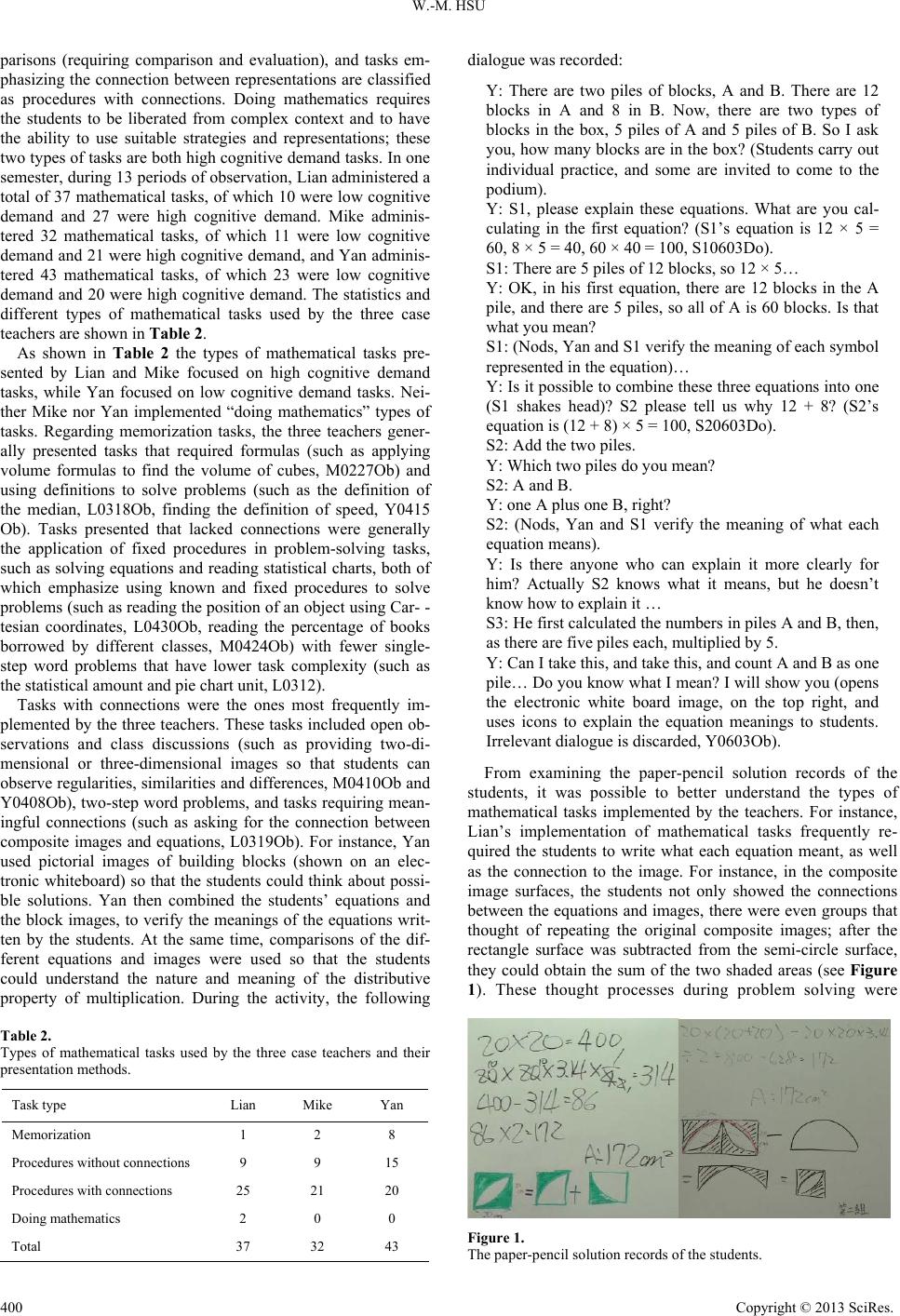 W.-M. HSU parisons (requiring comparison and evaluation), and tasks em- phasizing the connection between representations are classified as procedures with connections. Doing mathematics requires the students to be liberated from complex context and to have the ability to use suitable strategies and representations; these two types of tasks are both high cognitive demand tasks. In one semester, during 13 periods of observation, Lian administered a total of 37 mathematical tasks, of which 10 were low cognitive demand and 27 were high cognitive demand. Mike adminis- tered 32 mathematical tasks, of which 11 were low cognitive demand and 21 were high cognitive demand, and Yan adminis- tered 43 mathematical tasks, of which 23 were low cognitive demand and 20 were high cognitive demand. The statistics and different types of mathematical tasks used by the three case teachers are shown in Table 2. As shown in Table 2 the types of mathematical tasks pre- sented by Lian and Mike focused on high cognitive demand tasks, while Yan focused on low cognitive demand tasks. Nei- ther Mike nor Yan implemented “doing mathematics” types of tasks. Regarding memorization tasks, the three teachers gener- ally presented tasks that required formulas (such as applying volume formulas to find the volume of cubes, M0227Ob) and using definitions to solve problems (such as the definition of the median, L0318Ob, finding the definition of speed, Y0415 Ob). Tasks presented that lacked connections were generally the application of fixed procedures in problem-solving tasks, such as solving equations and reading statistical charts, both of which emphasize using known and fixed procedures to solve problems (such as reading the position of an object using Car- - tesian coordinates, L0430Ob, reading the percentage of books borrowed by different classes, M0424Ob) with fewer single- step word problems that have lower task complexity (such as the statistical amount and pie chart unit, L0312). Tasks with connections were the ones most frequently im- plemented by the three teachers. These tasks included open ob- servations and class discussions (such as providing two-di- mensional or three-dimensional images so that students can observe regularities, similarities and differences, M0410Ob and Y0408Ob), two-step word problems, and tasks requiring mean- ingful connections (such as asking for the connection between composite images and equations, L0319Ob). For instance, Yan used pictorial images of building blocks (shown on an elec- tronic whiteboard) so that the students could think about possi- ble solutions. Yan then combined the students’ equations and the block images, to verify the meanings of the equations writ- ten by the students. At the same time, comparisons of the dif- ferent equations and images were used so that the students could understand the nature and meaning of the distributive property of multiplication. During the activity, the following Table 2. Types of mathematical tasks used by the three case teachers and their presentation methods. Task type Lian Mike Yan Memorization 1 2 8 Procedures without connections 9 9 15 Procedures with conne ctions 25 21 20 Doing mathematics 2 0 0 Total 37 32 43 dialogue was recorded: Y: There are two piles of blocks, A and B. There are 12 blocks in A and 8 in B. Now, there are two types of blocks in the box, 5 piles of A and 5 piles of B. So I ask you, how many blocks are in the box? (Students carry out individual practice, and some are invited to come to the podium). Y: S1, please explain these equations. What are you cal- culating in the first equation? (S1’s equation is 12 × 5 = 60, 8 × 5 = 40, 60 × 40 = 100, S10603Do). S1: There are 5 piles of 12 blocks, so 12 × 5… Y: OK, in his first equation, there are 12 blocks in the A pile, and there are 5 piles, so all of A is 60 blocks. Is that what you mean? S1: (Nods, Yan and S1 verify the meaning of each symbol represented in the equation)… Y: Is it possible to combine these three equations into one (S1 shakes head)? S2 please tell us why 12 + 8? (S2’s equation is (12 + 8) × 5 = 100, S20603Do). S2: Add the two piles. Y: Which two piles do you mean? S2: A and B. Y: one A plus one B, right? S2: (Nods, Yan and S1 verify the meaning of what each equation means). Y: Is there anyone who can explain it more clearly for him? Actually S2 knows what it means, but he doesn’t know how to explain it … S3: He first calculated the numbers in piles A and B, then, as there are five piles each, multiplied by 5. Y: Can I take this, and take this, and count A and B as one pile… Do you know what I mean? I will show you (opens the electronic white board image, on the top right, and uses icons to explain the equation meanings to students. Irrelevant dialogue is discarded, Y0603Ob). From examining the paper-pencil solution records of the students, it was possible to better understand the types of mathematical tasks implemented by the teachers. For instance, Lian’s implementation of mathematical tasks frequently re- quired the students to write what each equation meant, as well as the connection to the image. For instance, in the composite image surfaces, the students not only showed the connections between the equations and images, there were even groups that thought of repeating the original composite images; after the rectangle surface was subtracted from the semi-circle surface, they could obtain the sum of the two shaded areas (see Figure 1). These thought processes during problem solving were Figure 1. The paper-pencil solution records of the students. Copyright © 2013 SciRe s . 400 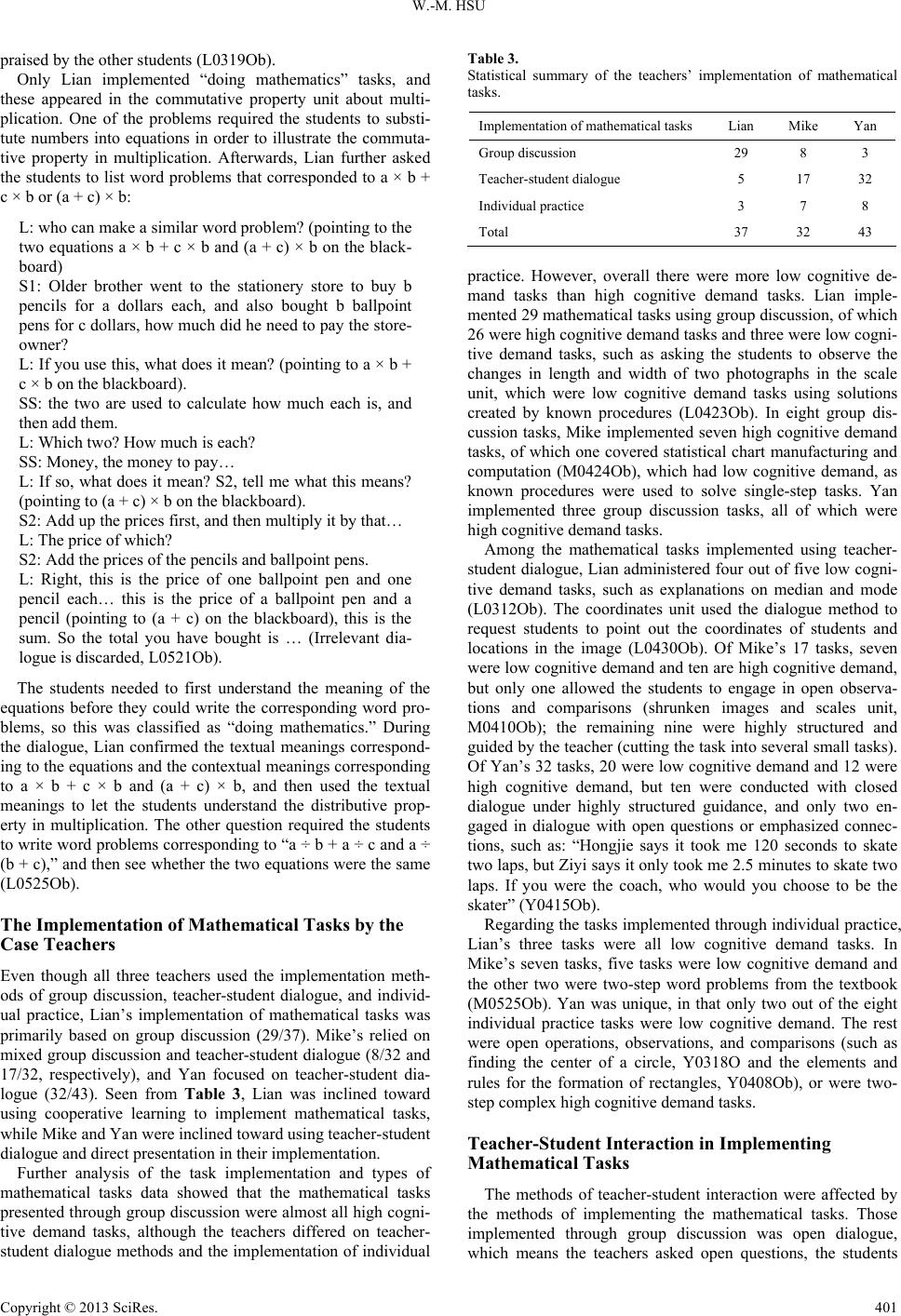 W.-M. HSU praised by the other students (L0319Ob). Only Lian implemented “doing mathematics” tasks, and these appeared in the commutative property unit about multi- plication. One of the problems required the students to substi- tute numbers into equations in order to illustrate the commuta- tive property in multiplication. Afterwards, Lian further asked the students to list word problems that corresponded to a × b + c × b or (a + c) × b: L: who can make a similar word problem? (pointing to the two equations a × b + c × b and (a + c) × b on the black- board) S1: Older brother went to the stationery store to buy b pencils for a dollars each, and also bought b ballpoint pens for c dollars, how much did he need to pay the store- owner? L: If you use this, what does it mean? (pointing to a × b + c × b on the blackboard). SS: the two are used to calculate how much each is, and then add them. L: Which two? How much is each? SS: Money, the money to pay… L: If so, what does it mea n? S2, tell me what this me ans? (pointing to (a + c) × b on the blackboard). S2: Add up the prices first, and then multiply it by that… L: The price of which? S2: Add the prices of the pencils and ballpoint pens. L: Right, this is the price of one ballpoint pen and one pencil each… this is the price of a ballpoint pen and a pencil (pointing to (a + c) on the blackboard), this is the sum. So the total you have bought is … (Irrelevant dia- logue is discarded, L0521Ob). The students needed to first understand the meaning of the equations before they could write the corresponding word pro- blems, so this was classified as “doing mathematics.” During the dialogue, Lian confirmed the textual meanings correspond- ing to the equations and the contextual meanings corresponding to a × b + c × b and (a + c) × b, and then used the textual meanings to let the students understand the distributive prop- erty in multiplication. The other question required the students to write word problems corresponding to “a ÷ b + a ÷ c and a ÷ (b + c),” and then see whether the two equations were the same (L0525Ob). The Implementation of Mathematical Tasks by the Case Teachers Even though all three teachers used the implementation meth- ods of group discussion, teacher-student dialogue, and individ- ual practice, Lian’s implementation of mathematical tasks was primarily based on group discussion (29/37). Mike’s relied on mixed group discussion and teacher-student dialogue (8/32 and 17/32, respectively), and Yan focused on teacher-student dia- logue (32/43). Seen from Table 3, Lian was inclined toward using cooperative learning to implement mathematical tasks, while Mike and Yan were inclined toward using teacher-student dialogue and direct presentation in their implementation. Further analysis of the task implementation and types of mathematical tasks data showed that the mathematical tasks presented through group discussion were almost all high cogni- tive demand tasks, although the teachers differed on teacher- student dialogue methods and the implementation of individual Table 3. Statistical summary of the teachers’ implementation of mathematical tasks. Implementation of math e matical tasks Lian Mike Yan Group disc us sion 29 8 3 Teacher-st udent dialogue 5 17 32 Individual practice 3 7 8 Total 37 32 43 practice. However, overall there were more low cognitive de- mand tasks than high cognitive demand tasks. Lian imple- mented 29 mathematical tasks using group discussion, of which 26 were high cognitive demand tasks and three were low cogni- tive demand tasks, such as asking the students to observe the changes in length and width of two photographs in the scale unit, which were low cognitive demand tasks using solutions created by known procedures (L0423Ob). In eight group dis- cussion tasks, Mike implemented seven high cognitive demand tasks, of which one covered statistical chart manufacturing and computation (M0424Ob), which had low cognitive demand, as known procedures were used to solve single-step tasks. Yan implemented three group discussion tasks, all of which were high cognitive demand tasks. Among the mathematical tasks implemented using teacher- student dialogue, Lian administered four out of five low cogni- tive demand tasks, such as explanations on median and mode (L0312Ob). The coordinates unit used the dialogue method to request students to point out the coordinates of students and locations in the image (L0430Ob). Of Mike’s 17 tasks, seven were low cognitive demand and ten are high cognitive demand, but only one allowed the students to engage in open observa- tions and comparisons (shrunken images and scales unit, M0410Ob); the remaining nine were highly structured and guided by the teacher (cutting the task into several small tasks). Of Yan’s 32 tasks, 20 were low cognitive demand and 12 were high cognitive demand, but ten were conducted with closed dialogue under highly structured guidance, and only two en- gaged in dialogue with open questions or emphasized connec- tions, such as: “Hongjie says it took me 120 seconds to skate two laps, but Ziyi says it only took me 2.5 minutes to skate two laps. If you were the coach, who would you choose to be the skater” (Y0415Ob). Regarding the tasks implemented through individual practice, Lian’s three tasks were all low cognitive demand tasks. In Mike’s seven tasks, five tasks were low cognitive demand and the other two were two-step word problems from the textbook (M0525Ob). Yan was unique, in that only two out of the eight individual practice tasks were low cognitive demand. The rest were open operations, observations, and comparisons (such as finding the center of a circle, Y0318O and the elements and rules for the formation of rectangles, Y0408Ob), or were two- step complex high cognitive demand tasks. Teacher-Student Interaction in Implementing Mathematical Tasks The methods of teacher-student interaction were affected by the methods of implementing the mathematical tasks. Those implemented through group discussion was open dialogue, which means the teachers asked open questions, the students Copyright © 2013 SciRe s . 401 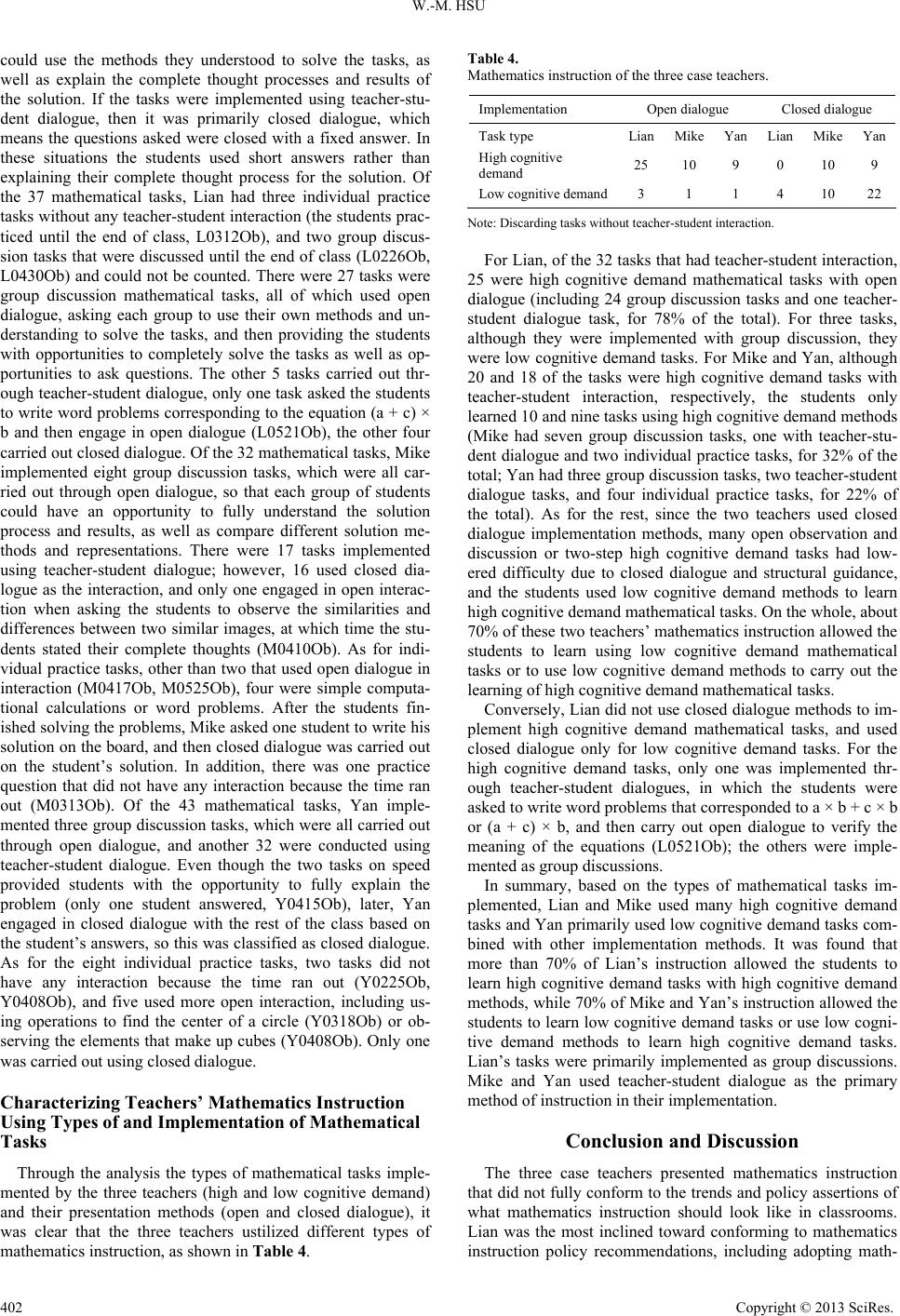 W.-M. HSU could use the methods they understood to solve the tasks, as well as explain the complete thought processes and results of the solution. If the tasks were implemented using teacher-stu- dent dialogue, then it was primarily closed dialogue, which means the questions asked were closed with a fixed answer. In these situations the students used short answers rather than explaining their complete thought process for the solution. Of the 37 mathematical tasks, Lian had three individual practice tasks without any teacher-student interaction (the students prac- ticed until the end of class, L0312Ob), and two group discus- sion tasks that were discussed until the end of class (L0226Ob, L0430Ob) and could not be counted. There were 27 tasks were group discussion mathematical tasks, all of which used open dialogue, asking each group to use their own methods and un- derstanding to solve the tasks, and then providing the students with opportunities to completely solve the tasks as well as op- portunities to ask questions. The other 5 tasks carried out thr- ough teacher-student dialogue, only one task asked the students to write word problems corresponding to the equation (a + c) × b and then engage in open dialogue (L0521Ob), the other four carried out closed dialogue. Of the 32 mathematical tasks, Mike implemented eight group discussion tasks, which were all car- ried out through open dialogue, so that each group of students could have an opportunity to fully understand the solution process and results, as well as compare different solution me- thods and representations. There were 17 tasks implemented using teacher-student dialogue; however, 16 used closed dia- logue as the interaction, and only one engaged in open interac- tion when asking the students to observe the similarities and differences between two similar images, at which time the stu- dents stated their complete thoughts (M0410Ob). As for indi- vidual practice tasks, other than two that used open dialogue in interaction (M0417Ob, M0525Ob), four were simple computa- tional calculations or word problems. After the students fin- ished solving the problems, Mike asked one student to write his solution on the board, and then closed dialogue was carried out on the student’s solution. In addition, there was one practice question that did not have any interaction because the time ran out (M0313Ob). Of the 43 mathematical tasks, Yan imple- mented three group discussion tasks, which were all carried out through open dialogue, and another 32 were conducted using teacher-student dialogue. Even though the two tasks on speed provided students with the opportunity to fully explain the problem (only one student answered, Y0415Ob), later, Yan engaged in closed dialogue with the rest of the class based on the student’s answers, so this was classified as closed dialogue. As for the eight individual practice tasks, two tasks did not have any interaction because the time ran out (Y0225Ob, Y0408Ob), and five used more open interaction, including us- ing operations to find the center of a circle (Y0318Ob) or ob- serving the elements that make up cubes (Y0408Ob). Only one was carried out using closed dialogue. Characterizin g Tea chers’ Mathematics Instruction Using Types of and Implementation of Mathematical Tasks Through the analysis the types of mathematical tasks imple- mented by the three teachers (high and low cognitive demand) and their presentation methods (open and closed dialogue), it was clear that the three teachers ustilized different types of mathematics instruction, as shown in Table 4. Table 4. Mathematics instruction of the three case teachers. Implementation Open dialogue Closed dialogue Task type LianMike Yan Lian MikeYan High cognitive demand 25 10 9 0 10 9 Low cogniti ve demand 3 1 1 4 10 22 Note: Discarding tasks without teacher-student interaction. For Lian, of the 32 tasks that had teacher-student interaction, 25 were high cognitive demand mathematical tasks with open dialogue (including 24 group discussion tasks and one teacher- student dialogue task, for 78% of the total). For three tasks, although they were implemented with group discussion, they were low cognitive demand tasks. For Mike and Yan, although 20 and 18 of the tasks were high cognitive demand tasks with teacher-student interaction, respectively, the students only learned 10 and nine tasks using high cognitive demand methods (Mike had seven group discussion tasks, one with teacher-stu- dent dialogue and two individual practice tasks, for 32% of the total; Yan had three group discussion tasks, two teacher-student dialogue tasks, and four individual practice tasks, for 22% of the total). As for the rest, since the two teachers used closed dialogue implementation methods, many open observation and discussion or two-step high cognitive demand tasks had low- ered difficulty due to closed dialogue and structural guidance, and the students used low cognitive demand methods to learn high cognitive demand mathematical tasks. On the whole, about 70% of these two teachers’ mathematics instruction allowed the students to learn using low cognitive demand mathematical tasks or to use low cognitive demand methods to carry out the learning of high cognitive demand mathematical tasks. Conversely, Lian did not use closed dialogue methods to im- plement high cognitive demand mathematical tasks, and used closed dialogue only for low cognitive demand tasks. For the high cognitive demand tasks, only one was implemented thr- ough teacher-student dialogues, in which the students were asked to write word problems that corresponded to a × b + c × b or (a + c) × b, and then carry out open dialogue to verify the meaning of the equations (L0521Ob); the others were imple- mented as group discussions. In summary, based on the types of mathematical tasks im- plemented, Lian and Mike used many high cognitive demand tasks and Yan primarily used low cognitive demand tasks com- bined with other implementation methods. It was found that more than 70% of Lian’s instruction allowed the students to learn high cognitive demand tasks with high cognitive demand methods, while 70% of Mike and Yan’s instruction allowed the students to learn low cognitive demand tasks or use low cogni- tive demand methods to learn high cognitive demand tasks. Lian’s tasks were primarily implemented as group discussions. Mike and Yan used teacher-student dialogue as the primary method of instruction in their implementation. Conclusion and Discussion The three case teachers presented mathematics instruction that did not fully conform to the trends and policy assertions of what mathematics instruction should look like in classrooms. Lian was the most inclined toward conforming to mathematics instruction policy recommendations, including adopting math- Copyright © 2013 SciRe s . 402 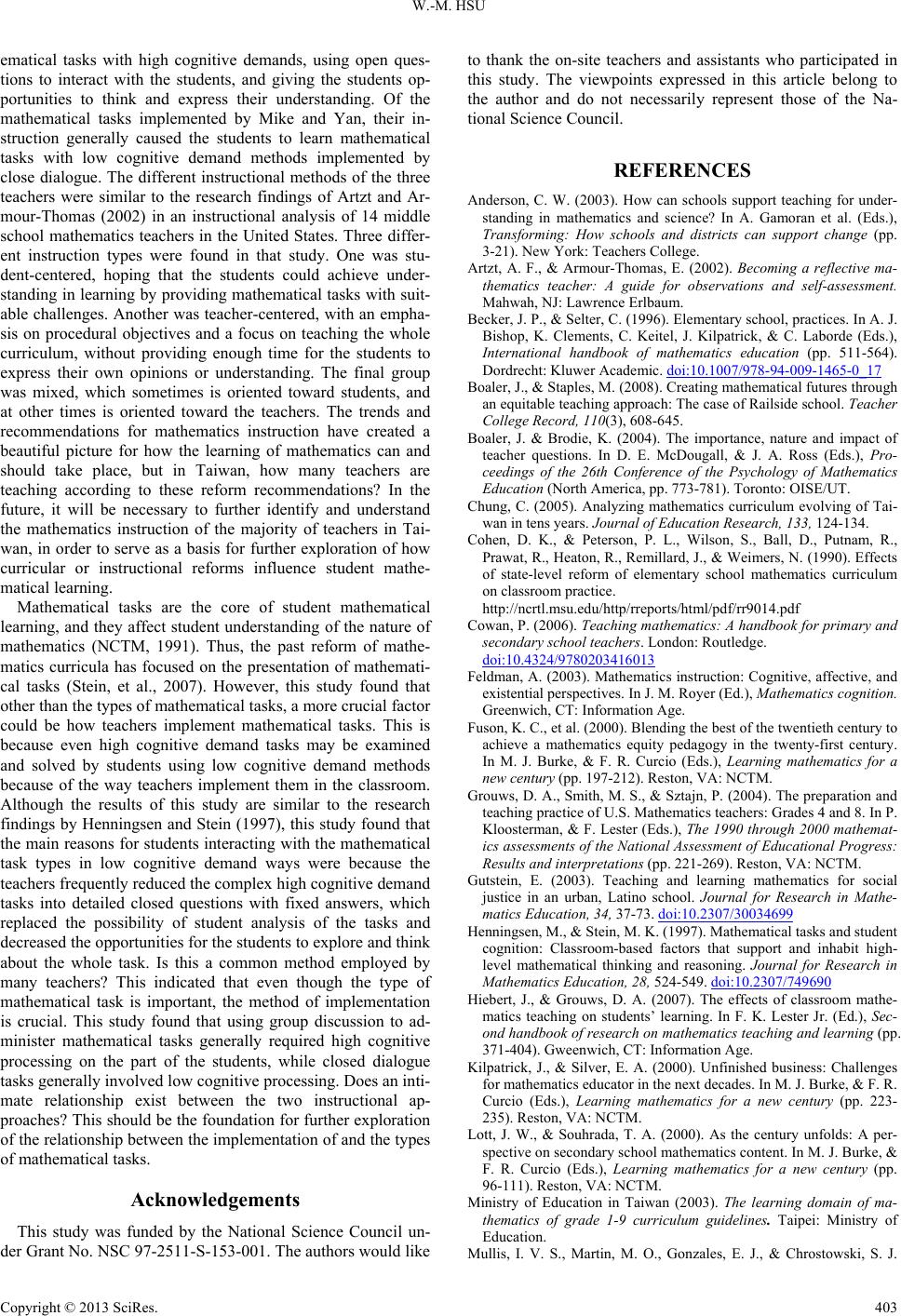 W.-M. HSU ematical tasks with high cognitive demands, using open ques- tions to interact with the students, and giving the students op- portunities to think and express their understanding. Of the mathematical tasks implemented by Mike and Yan, their in- struction generally caused the students to learn mathematical tasks with low cognitive demand methods implemented by close dialogue. The different instructional methods of the three teachers were similar to the research findings of Artzt and Ar- mour-Thomas (2002) in an instructional analysis of 14 middle school mathematics teachers in the United States. Three differ- ent instruction types were found in that study. One was stu- dent-centered, hoping that the students could achieve under- standing in learning by providing mathematical tasks with suit- able challenges. Another was teacher-centered, with an empha- sis on procedural objectives and a focus on teaching the whole curriculum, without providing enough time for the students to express their own opinions or understanding. The final group was mixed, which sometimes is oriented toward students, and at other times is oriented toward the teachers. The trends and recommendations for mathematics instruction have created a beautiful picture for how the learning of mathematics can and should take place, but in Taiwan, how many teachers are teaching according to these reform recommendations? In the future, it will be necessary to further identify and understand the mathematics instruction of the majority of teachers in Tai- wan, in order to serve as a basis for further exploration of how curricular or instructional reforms influence student mathe- matical learning. Mathematical tasks are the core of student mathematical learning, and they affect student understanding of the nature of mathematics (NCTM, 1991). Thus, the past reform of mathe- matics curricula has focused on the presentation of mathemati- cal tasks (Stein, et al., 2007). However, this study found that other than the types of mathematical tasks, a more crucial factor could be how teachers implement mathematical tasks. This is because even high cognitive demand tasks may be examined and solved by students using low cognitive demand methods because of the way teachers implement them in the classroom. Although the results of this study are similar to the research findings by Henningsen and Stein (1997), this study found that the main reasons for students interacting with the mathematical task types in low cognitive demand ways were because the teachers frequently reduced the complex high cognitive demand tasks into detailed closed questions with fixed answers, which replaced the possibility of student analysis of the tasks and decreased the opportunities for the students to explore and think about the whole task. Is this a common method employed by many teachers? This indicated that even though the type of mathematical task is important, the method of implementation is crucial. This study found that using group discussion to ad- minister mathematical tasks generally required high cognitive processing on the part of the students, while closed dialogue tasks generally involved low cognitive processing. Does an inti- mate relationship exist between the two instructional ap- proaches? This should be the foundation for further exploration of the relationship between the implementation of and the types of mathematical tasks. Acknowledgements This study was funded by the National Science Council un- der Grant No. NSC 97-2511-S-153-001. The authors would like to thank the on-site teachers and assistants who participated in this study. The viewpoints expressed in this article belong to the author and do not necessarily represent those of the Na- tional Science Council. REFERENCES Anderson, C. W. (2003). How can schools support teaching for under- standing in mathematics and science? In A. Gamoran et al. (Eds.), Transforming: How schools and districts can support change (pp. 3-21). New York: Teachers College. Artzt, A. F., & Armour-Thomas, E. (2002). Becoming a reflective ma- thematics teacher: A guide for observations and self-assessment. Mahwah, NJ: Lawrence Erlbaum. Becker, J. P., & Selter, C. (1996). Elementary school, practices. In A. J. Bishop, K. Clements, C. Keitel, J. Kilpatrick, & C. Laborde (Eds.), International handbook of mathematics education (pp. 511-564). Dordrecht: Kluwer Academic. doi:10.1007/978-94-009-1465-0_17 Boaler, J., & Staples, M. (2008). Creating mathematical futures through an equitable teaching approach: The case of Railside school. Teacher College Record, 110(3), 608-645. Boaler, J. & Brodie, K. (2004). The importance, nature and impact of teacher questions. In D. E. McDougall, & J. A. Ross (Eds.), Pro- ceedings of the 26th Conference of the Psychology of Mathematics Education (North A merica, pp. 773-781). Toronto: OI SE/UT. Chung, C. (2005). Analyzing mathematics curriculum evolving of Tai- wan in tens years. Journal of Education Research, 133, 124-134. Cohen, D. K., & Peterson, P. L., Wilson, S., Ball, D., Putnam, R., Prawat, R., Heaton, R., Remillard, J., & Weimers, N. (1990). Effects of state-level reform of elementary school mathematics curriculum on classroom practice. http://ncrtl.msu.edu/http/rreports/html/pdf/rr9014.pdf Cowan, P. (2006). Teaching mathematics: A handbook for primary and secondary school teachers. London: Routle dg e. doi:10.4324/9780203416013 Feldman, A. (2003). Mathematics instruction: Cognitive, affective, and existential perspectives. In J. M. Royer (Ed. ), Mathematics cognition. Greenwich, CT: Information Age. Fuson, K. C., et al. (2000). Blending the best of the twentieth century to achieve a mathematics equity pedagogy in the twenty-first century. In M. J. Burke, & F. R. Curcio (Eds.), Learning mathematics for a new century (pp. 19 7-212). Reston, VA: NCTM. Grouws, D. A., Smith, M. S., & Sztajn, P. (2004). The preparation and teaching practice of U.S. Mathematics teachers: Grades 4 and 8. In P. Kloosterman, & F. Lester ( Eds.), The 1990 through 2000 mathemat- ics assessments of the National Assessment of Educational Progress: Results and interpretations (pp. 221-269). Reston, VA: NCTM. Gutstein, E. (2003). Teaching and learning mathematics for social justice in an urban, Latino school. Journal for Research in Mathe- matics Education, 34, 37-73. doi:10.2307/30034699 Henningsen, M., & Stein, M. K. (1997). Mathematical tasks and student cognition: Classroom-based factors that support and inhabit high- level mathematical thinking and reasoning. Journal for Research in Mathematics Education, 28, 524-549. doi:10.2307/749690 Hiebert, J., & Grouws, D. A. (2007). The effects of classroom mathe- matics teaching on students’ learning. In F. K. Lester Jr. (Ed.), Sec- ond handbook of research on mathematics teaching and learning (pp. 371-404). Gweenwich, CT : Information Age. Kilpatrick, J., & Silver, E. A. (2000). Unfinished business: Challenges for mathematics educator in the next decades. In M. J. Burke, & F. R. Curcio (Eds.), Learning mathematics for a new century (pp. 223- 235). Reston, VA: NCTM. Lott, J. W., & Souhrada, T. A. (2000). As the century unfolds: A per- spective on secondary school mathematics content. In M. J. Burke, & F. R. Curcio (Eds.), Learning mathematics for a new century (pp. 96-111). Reston, VA: NC TM. Ministry of Education in Taiwan (2003). The learning domain of ma- thematics of grade 1-9 curriculum guidelines. Taipei: Ministry of Education. Mullis, I. V. S., Martin, M. O., Gonzales, E. J., & Chrostowski, S. J. Copyright © 2013 SciRe s . 403 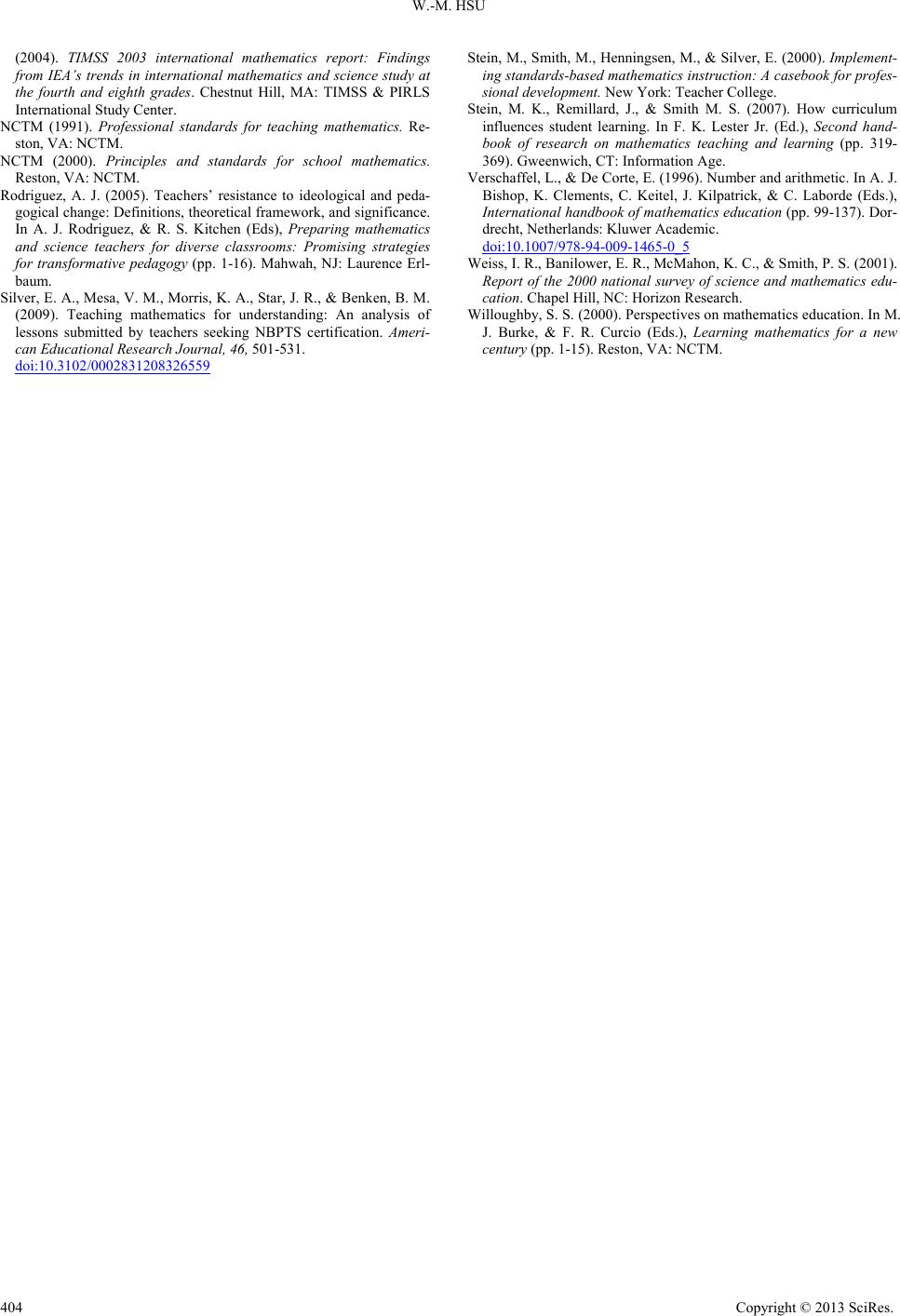 W.-M. HSU Copyright © 2013 SciRes. 404 (2004). TIMSS 2003 international mathematics report: Findings from IEA’s trends in international mathematics and science study at the fourth and eighth grades. Chestnut Hill, MA: TIMSS & PIRLS International Study Center. NCTM (1991). Professional standards for teaching mathematics. Re- ston, VA: NCTM. NCTM (2000). Principles and standards for school mathematics. Reston, VA: NCTM. Rodriguez, A. J. (2005). Teachers’ resistance to ideological and peda- gogical change: Definitions, theoretical framework, and significance. In A. J. Rodriguez, & R. S. Kitchen (Eds), Preparing mathematics and science teachers for diverse classrooms: Promising strategies for transformative pedagogy (pp. 1-16). Mahwah, NJ: Laurence Erl- baum. Silver, E. A., Mesa, V. M., Morris, K. A., Star, J. R ., & Benken, B. M. (2009). Teaching mathematics for understanding: An analysis of lessons submitted by teachers seeking NBPTS certification. Ameri- can Educational Research Journal, 46, 501-531. doi:10.3102/0002831208326559 Stein, M., Smith, M., Henningsen, M., & Silver, E. (2000). Implement- ing standards-based mathematics instruction: A casebook for profes- sional development. New York: Teacher College. Stein, M. K., Remillard, J., & Smith M. S. (2007). How curriculum influences student learning. In F. K. Lester Jr. (Ed.), Second hand- book of research on mathematics teaching and learning (pp. 319- 369). Gweenwich, CT: Information Age. Verschaffel, L., & De Corte, E. (1996). Number and arithmetic. In A. J. Bishop, K. Clements, C. Keitel, J. Kilpatrick, & C. Laborde (Eds.), International handbook of mathematics education (pp. 99-137). Dor- drecht, Netherlands: Kluwer Academic. doi:10.1007/978-94-009-1465-0_5 Weiss, I. R., Banilower, E. R., McMahon, K. C., & Smith, P. S. (2001). Report of the 2000 national survey of science and mathematics edu- cation. Chapel Hill, NC: Horizon Research. Willoughby, S. S. (2000). Perspectives on mathematics education. In M. J. Burke, & F. R. Curcio (Eds.), Learning mathematics for a new century (pp. 1-15). Reston, VA: NCTM.
|